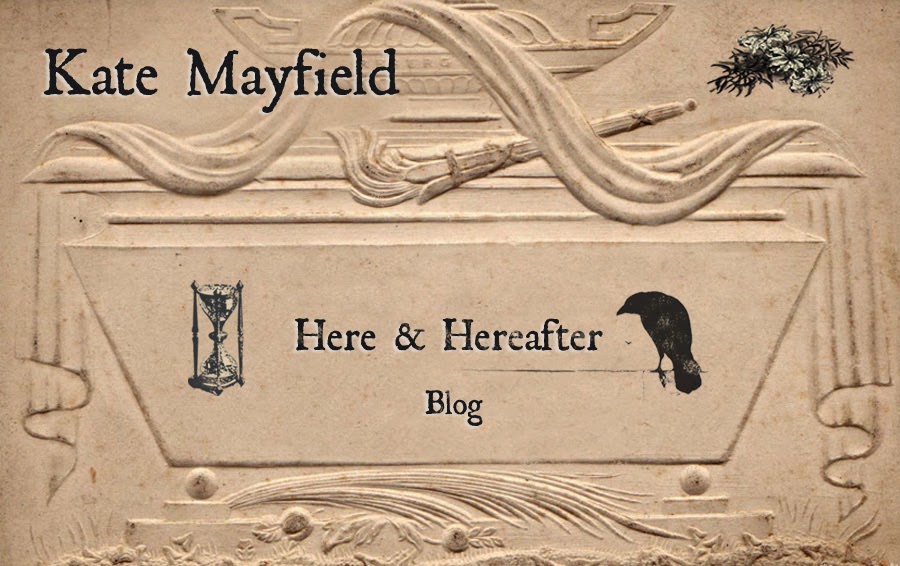
As a young girl the most natural thing in the world to me was to play in the town cemetery. I often hopped in the car with my father when his business took him to our town’s burial ground. He checked on graves, stopped by to place a marker in the rich soil, or had a word with his gravediggers.

A tent often protected a fresh, open grave until the graveside service was over, or in case the skies poured before it was time to backfill. If a storm blew through we drove by to make sure the tent hadn’t collapsed. There was always something to do at the cemetery.

We spent a lot of time across the street from the cemetery sitting at a Formica counter where he drank coffee with the men.

A waitress with a beehive and large orange lips always gave me a wink before setting a plate of pie topped with a tall meringue in front of me. I twirled around on the stool, fork in hand and admired the view of the cemetery from that perspective.

Old Cemetery by paprika-jancsi
One day my father reached into his pocket and pulled out a large iron key. It was the key of mystery, the key that opened the door to an anomaly; there were only two mausoleums in our county.

My father fiddled with the key in the rusty lock and struggled with the heavy chain on the door. When my eyes adjusted to the darkness, I was surprised to see how small the space was. He explained the drawers and answered my questions about the strange, deceptively empty storage room. Stone vases jutting out from the wall awaited fresh flowers. I was relieved to spot a small vent at the top of the wall. At least we wouldn’t suffocate if we were accidentally locked in. The mausoleum really wasn’t as much fun as I expected.
Tombstone, gravestone, monument, headstone - all names for the thing that marks a plot of land and the person who was. My favorite cluster:

The Hardy Tree St. Pancras Churchyard
I was partial to a particular tombstone erected in the early nineteenth century decorated with images of the deceased husband and wife, each sepia toned photo was displayed on porcelain plaques and framed in brass ovals. I visited their tombstone regularly, as if I knew them.
Many years later, although too soon, much too soon, my father died an early death and was buried in the cemetery in which we’d spent so much time together. Years later still, I came back to the cemetery to visit his grave. I felt I had a complete intimacy with our little necropolis. I thought I knew every turning, every tree, every tombstone that marked the path to my father’s own tombstone. I drove through confidently with my British husband, who was visiting Kentucky for the first time and already in a deep state of culture shock, when the unthinkable happened. I couldn’t find my father’s grave.
I drove round and round in circles. The paved pathways in the small cemetery, hardly roads, had no names, but I was certain of my surroundings. “I’m sure it’s here.” I said one too many times. I drove down different paths; perhaps the cemetery had grown a great deal more than I thought. I stopped the car, laughing at how ridiculous it was. I got out and walked around, then got back in and drove around again. After an hour of this, my husband, perplexed and attempting to be helpful, gently suggested that we’d been on this route before, perhaps we should ask someone. “You must be joking. I absolutely will not ask anyone where my own father is buried!” But the fact was that I couldn’t find his grave and now it was not funny at all.
I tried to remain calm, but in all truth, I verged on the hysterical. How was I to tell my mother that someone had stolen my father’s tombstone? I didn’t know how and I didn’t know why, but stolen it was. It was the only possible answer. I called my sister.
“Are you sitting down, because I have something terrible to tell you.”
“What is it?”
“I don’t know how we’re going to tell Mother.”
“For god’s sake, what?”
“Daddy’s tombstone is gone. Someone’s stolen it!
She burst into laughter.
I was shocked into a stupor of silence by her reaction.
“We had it removed for further engraving. We’ve just now gotten around to it. It’ll be ready in a couple of weeks.”
“Oh.” Long pause. “I thought it was something like that.”
“Right. Sure you did.”












